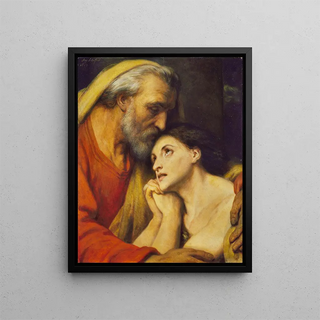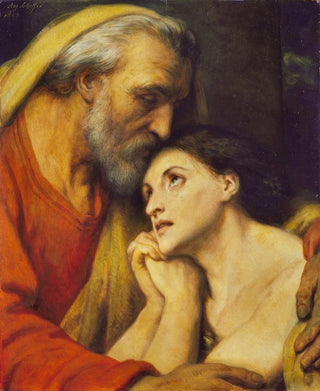Painting The Return of the Prodigal Son - Ary Scheffer | Art print


View from behind

Frame (optional)
In the vast panorama of art history, certain works stand out for their ability to evoke deep and universal emotions. "The Return of the Prodigal Son" by Ary Scheffer is one of these masterpieces. This artwork, inspired by the famous biblical parable, powerfully illustrates the themes of forgiveness and redemption. Through this depiction, Scheffer invites us to contemplate the complex dynamics of human relationships, while immersing us in an atmosphere charged with spirituality. The scene, where the prodigal son reunites with his father, is imbued with palpable tenderness, capturing a moment of reunion that transcends time and space.
Style and uniqueness of the work
Ary Scheffer's style is recognizable by its romantic approach, blending meticulous technique with emotional expressiveness. In "The Return of the Prodigal Son," the figures are rendered with delicacy that highlights the nuances of feelings. The faces, finely modeled, reveal a range of emotions from pain to joy, while the drapery of the clothing seems to dance with the light, adding a tactile dimension to the composition. The color palette chosen by the artist, both soft and warm, creates an intimate atmosphere that draws the viewer into the sacred scene's intimacy. Every detail, from outstretched hands to exchanged glances, contributes to the visual storytelling, making this artwork not only a feast for the eyes but also an invitation to reflect on human nature.
The artist and his influence
Ary Scheffer, born in 1795, is an emblematic figure of the Romantic movement in France. His career, marked by an incessant quest for beauty and emotion, influenced many artists of his time and future generations. Trained at the Académie des Beaux-Arts, he managed to combine classical traditions with Romantic aspirations, creating works that speak directly to the soul. Scheffer was also a fervent advocate of religious art, seeking to reinterpret ancient themes for a contemporary audience. His work "The Return of the Prodigal Son" exemplifies this approach, where

Matte finish

View from behind

Frame (optional)
In the vast panorama of art history, certain works stand out for their ability to evoke deep and universal emotions. "The Return of the Prodigal Son" by Ary Scheffer is one of these masterpieces. This artwork, inspired by the famous biblical parable, powerfully illustrates the themes of forgiveness and redemption. Through this depiction, Scheffer invites us to contemplate the complex dynamics of human relationships, while immersing us in an atmosphere charged with spirituality. The scene, where the prodigal son reunites with his father, is imbued with palpable tenderness, capturing a moment of reunion that transcends time and space.
Style and uniqueness of the work
Ary Scheffer's style is recognizable by its romantic approach, blending meticulous technique with emotional expressiveness. In "The Return of the Prodigal Son," the figures are rendered with delicacy that highlights the nuances of feelings. The faces, finely modeled, reveal a range of emotions from pain to joy, while the drapery of the clothing seems to dance with the light, adding a tactile dimension to the composition. The color palette chosen by the artist, both soft and warm, creates an intimate atmosphere that draws the viewer into the sacred scene's intimacy. Every detail, from outstretched hands to exchanged glances, contributes to the visual storytelling, making this artwork not only a feast for the eyes but also an invitation to reflect on human nature.
The artist and his influence
Ary Scheffer, born in 1795, is an emblematic figure of the Romantic movement in France. His career, marked by an incessant quest for beauty and emotion, influenced many artists of his time and future generations. Trained at the Académie des Beaux-Arts, he managed to combine classical traditions with Romantic aspirations, creating works that speak directly to the soul. Scheffer was also a fervent advocate of religious art, seeking to reinterpret ancient themes for a contemporary audience. His work "The Return of the Prodigal Son" exemplifies this approach, where
12,34 €






